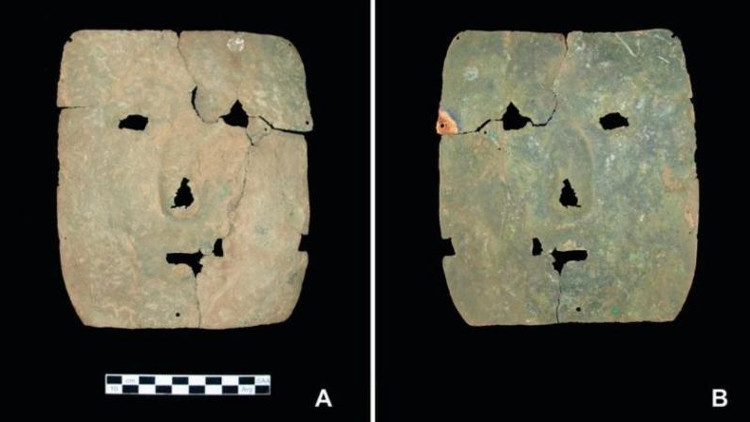Detect a tremor from an ancient 3000-year-old mask in Argentina
On June 8, Argentine archaeologists announced the discovery of a rectangular bronze mask dating back 3,000 years in the Andes Mountains, questioning the theory that Peru is the starting point of the pre-Columbian metallurgy profession in South America.
This is the oldest man-made bronze item found in this area. However, the greatest concern of archaeologists is that the ancient mask was discovered in Cajon Valley, located in the Andes Mountains in northwestern Argentina.
The mask was used during a funeral 3,000 years ago, during the period when people abandoned the nomadic hunting and gathering life, began to settle permanently with farming and livestock.

The front (left) and the back (right) of the mask.(Source: dailymail.co.uk).
Researchers at the University of Buenos Aires identified the discovery as a proof that the Cajon Valley and surrounding area were once a center for important bronze objects.
The neck mask is 18cm long, 15cm wide, handcrafted, mound from the middle to the outside with holes in the position of eyes, nose, mouth and smaller holes on the edges used to hold the face.
Rain water revealed a mask along with 14 ancient human remains gathered in a grave near La Quebrada province, northwest of Argentina.
Nearby, scientists also discovered a second burial site, but only one remains of 12-year-old children dating back 3,000 years.
In addition, experts also discovered ore deposits that were located nearly 70km away from Cajon valley. It was discovered that the mask made here and possibly metallurgical began in Argentina, not in Peru as the previous study indicated.
Earlier, many bronze artifacts dating back about 1,000 years were found in Peru's Andes. However, archaeologists have not yet determined whether these items are produced here or brought to Peru through commercial activities.
- Detect tremors about Pacal the Great Mayan
- Israel showcased a 9,000-year-old sandstone neck mask
- Discover the oldest ritual mask in Japan
- Restores the beard on the 3,300-year-old gold mask
- Dispute the yellow mask of the 3,200-year mummy
- Successfully fabricated the 'Ironman' mask
- Fossilized 3.5 million years of pangolin in Argentina
- Reconstruction of the ancient
- The mask of the dead reveals the portrait of the ancient Siberian people
- Ultrasound helps treat tremor in older people
- Masks with fans, exhaust valves for hot days
- Admire the 60,000-year-old Aboriginal mask in Hanoi
 Discovered an ancient centipede fossil 99 million years old
Discovered an ancient centipede fossil 99 million years old Discovered bat-like dinosaurs in China
Discovered bat-like dinosaurs in China Discovered a 200-year-old bronze cannon of the coast
Discovered a 200-year-old bronze cannon of the coast Discover 305 million-year-old spider fossils
Discover 305 million-year-old spider fossils